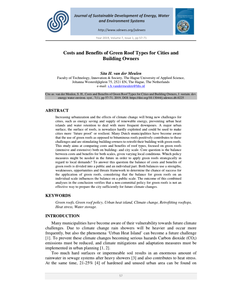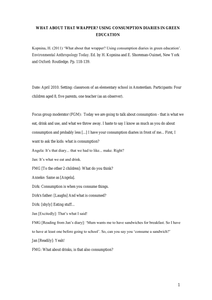Evenementen en Festivals zijn voor steden tegenwoordig serious business. Ze zijn bepalend voor het imago van de organiserende stad en ze trekken honderdduizenden bezoekers, voor wie het soms een eerste kennismaking met de stad betekent. Zo ook voor de gemeente Den Haag die haar evenementen prominent inzet als stedelijk marketinginstrument. Daarnaast zorgen evenementen jaarlijks voor enkele miljoenen euro's aan omzet en dus ook voor werkgelegenheid in de stad. De gemeente Den Haag wil weten of haar evenementen milieubewuster kunnen en is op zoek naar praktische mogelijkheden. Tegelijkertijd staat het behoud en de stimulering van evenementen hoog in het vaandel. Daarom heeft wethouder Duurzaamheid, de heer R. Smits aan de Haagse Hogeschool gevraagd een 'Roadmap' voor Green Events op te stellen. Dit in het kader van het 'Partnership Duurzame Transitie Den Haag' De Haagse Hogeschool heeft, ter aanvulling van de eigen expertise, advies- en ingenieursbureau DHV ingeschakeld om de vraag van de gemeente Den Haag te beantwoorden. Een 'Green Event' is een evenement met een uitgekiend milieuplan. Daarbij gaat het om mogelijke maatregelen op het gebied van watergebruik, energie, mobiliteit (hoe komen en gaan de bezoekers) en afval. De Kernvraag van het onderzoek is: Hoe kan op efficiënte en evenementvriendelijke manier een 'vergroening' van de Haagse evenementen worden doorgevoerd?
DOCUMENT

Almere is a green city where the greenery extends into the centre through a framework of nature, forests, parks and canals. With this green environment, Almere fulfils an important condition for a liveable city, where it is pleasant to live and work. An important goal for the municipality is to challenge its residents to develop a healthy lifestyle by using that green framework.But what really motivates Almeerders to go outside to exercise, enjoy the surroundings and meet each other? Are there sufficient green meeting or sports facilities nearby? Could the routes that connect the living and working environment with the larger parks or forests be better designed? And can those routes simultaneously contribute to climate adaptation?With the Green Escape Challenge, we invited students and young professionals to work on these assignments together.
DOCUMENT

Increasing urbanization and the effects of climate change will bring new challenges for cities, such as energy saving and supply of renewable energy, preventing urban heat islands and water retention to deal with more frequent downpours. A major urban surface, the surface of roofs, is nowadays hardly exploited and could be used to make cities more ‘future proof’ or resilient. Many Dutch municipalities have become aware that the use of green roofs as opposed to bituminous roofs positively contributes to these challenges and are stimulating building-owners to retrofit their building with green roofs. This study aims at comparing costs and benefits of roof types, focused on green roofs (intensive and extensive) both on building- and city scale. Core question is the balance between costs and benefits for both scales, given varying local conditions. Which policy measures might be needed in the future in order to apply green roofs strategically in regard to local demands? To answer this question the balance of costs and benefits of green roofs is divided into a public and an individual part. Both balances use a strengths, weaknesses, opportunities and threats framework to determine the chance of success for the application of green roofs, considering that the balance for green roofs on an individual scale influences the balance on a public scale. The outcome of this combined analyses in the conclusion verifies that a responsible policy and a local approach towards green roofs is necessary to prepare the city sufficiently for future climate changes. http://dx.doi.org/10.13044/j.sdewes.d6.0225
MULTIFILE

Cities worldwide are growing at unprecedented rates, compromising their surrounding landscapes, and consuming many scarce resources. As a consequence, this will increase the compactness of cities and will also decrease the availability of urban green space. In recent years, many Dutch municipalities have cut back on municipal green space and itsmaintenance. To offer a liveable environment in 30 to 50 years, cities must face challenges head-on and strive to create green urban areas that build on liveable and coherent sustainable circular subsystems.
DOCUMENT

This booklet reports on experiments carried out by Van Hall Larenstein University of Applied Sciences in the context of the VALUE project. It consists of three parts. The first two chapters describe some experiments carried out in the Dutch town of Amersfoort and the students’ input and approach. This is followed by an intermezzo on sources of inspiration outside the Netherlands and examples of the way urban green spaces and elements can provide an impulse for towns and cities. The final two chapters concern the way such a green strategy can be designed in Dutch urban settings. Chapter 5 discusses how local governments can use the added value provided by urban green spaces for new investments:value capturing. Chapter 6 focuses on a new type of planning: Planning by Surprise, which combines dreams and pragmatism. The photo essay at the centre of the book tells the story of the many sides of green spaces in towns and cities. Unintentional, intentional, planned, dreamed of, drawn,remembered, pictured, developed: Planning by Surprise.
DOCUMENT

This paper describes a project to explore the possibilities of virtual worlds in educating Green IT. In the project a virtual world has been created with various assignments which are meant to create awareness on sustainability aspects of IT. The world (and the assignments) will be incorporated in a course for first-year IT students. In order to measure the effects of the course, a questionnaire has been developed which can be used before and after the course to measure the attitude towards green IT.
DOCUMENT

The issues in our field are complex and demand a ‘unifying organisation and pioneer’ that can make a substantial contribution to a future in which there is sufficient healthy food in a healthy living environment. Our Institution Plan describes how we, HAS green academy, intend to make that contribution.
DOCUMENT

Environmental or ‘green' education is an important driving force behind the ‘greening' of society as it plays a critical role in raising environmental awareness and preparing students for green jobs. None of the existing environmental attitudes and behavior measures is focused on the evaluation of green education, especially in relation to consumption. To date, no longitudinal studies of children and students' attitudes towards consumption influenced by education exist. Also, little has been done to explore the socio-cultural context in which attitudes toward consumption are being formed and to explain the cross-cultural differences in environmental attitudes. This pilot study is designed to take the first step towards developing methods complementing existing quantitative measurements with qualitative strategies, such as consumption diaries, focus groups, and concept mapping. While this research is just a first attempt to tackle children's knowledge and attitudes consumption, preliminary results of the research on which this chapter is based and enthusiasm of the research participants encourage the author to stress the importance of consumption studies as part of green education for educational program developers. As a chapter of this volume, the author hopes that this study will add to the anthropological depository of research on the cultural variants in the perception of the environment in children. This chapter draws upon the consumption diaries collected from the upper-elementary school children in Amsterdam, The Netherlands, between September 2009 and May 2010. Consumption diaries are chronological documents recording purchase, use, and waste of materials, which can be used both as analytical tools and the means to stimulate environmental awareness. The four main methodological steps involved in this research were as follows. Children were asked to complete the consumption diary, paying specific attention to use and waste materials. Consequently, focus group meetings were held with parents and their children to discuss the diaries. Finally, interviews with the children were conducted in order to generate statements that supplement those generated by focus groups for carrying out the concept mapping analysis. The concept mapping analysis was then conducted to organize the order and analyze the ideas expressed in the focus group and interview sessions. This is an Accepted Manuscript of a book chapter published by Routledge/CRC Press in "Environmental Anthropology Today" on 8/5/11 available online: https://doi.org/10.4324/9780203806906 LinkedIn: https://www.linkedin.com/in/helenkopnina/
MULTIFILE

Swales are widely used Sustainable Urban Drainage Systems (SuDS) that can reduce peak flow, collect and retain water and improve groundwater recharge. Most previous research has focused on the unsaturated infiltration rates of swales without considering the variation in infiltration rates under extreme climate events, such as multiple stormwater events after a long drought period. Therefore, fieldwork was carried out to collect hydraulic data of three swales under drought conditions followed by high precipitation. For this simulation, a new full-scale infiltration method was used to simulate five rainfall events filling up the total storage volume of the swales under drought conditions. The results were then compared to earlier research under regular circumstances. The results of this study show that three swales situated in the same street show a variation in initial infiltration capacity of 1.6 to 11.9 m/d and show higher infiltration rates under drought conditions. The saturated infiltration rate is up to a factor 4 lower than the initial unsaturated rate with a minimal rate of 0.5 m/d, close to the minimum required infiltration rate. Significant spatial and time variable infiltration rates are also found at similar research locations with multiple green infrastructures in close range. If the unsaturated infiltration capacity is used as the design input for computer models, the infiltration capacity may be significantly overestimated. The innovative method and the results of this study should help stormwater managers to test, model, plan and schedule maintenance requirements with more confidence, so that they will continue to perform satisfactorily over their intended design lifespan.
DOCUMENT